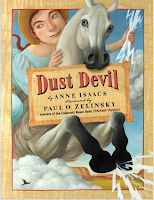A. Bibliography
Isaacs, Anne. 1994. Swamp angel. Ill. by Paul O. Zelinsky.
New York, NY: The Puffin Group. ISBN:
0525452710
B. Plot Summary
Angelica Longrider was born
on August 1, 1815 and she was “scarcely taller than her mother and couldn’t
climb a tree without help.” Angelica
became known as Swamp Angel when she was 12 because she aided in the rescue of
a wagon train that "got mired in Dejection Swamp". Swamp Angel was always looking for ways to
help people and one summer she came to the rescue of the people of Tennessee
when a huge bear named Thundering Tarnation was harassing them. Despite the fact that she was a women, she
overcame the “hoots and taunts” by many men who signed-up to hunt and fight the
bear. Swamp Angel killed the huge bear
to save the people of Tennessee. This tall tale is one that presents a strong, independent women capable of anything she set her mind to.
C. Critical Analysis
Swamp
Angel is a giant, pioneer woman. She
could be compared to the likeness of Paul Bunyan.
Anne Isaacs crafted a beautiful main character that displays strength,
wit and humanity. The first time the
reader hears Swamp Angel speak is when she responds to a gentleman taunting her about
being at home quilting instead of signing-up to fight a bear. She responds to the gentlemen by saying, “Quiltin’ is men’s work!” This shows that she has spunk and she isn't going to be bullied by anyone. Swamp
Angel’s conflict occurs when she meets Thundering Tarnation. Swamp Angel shows her tenacity when she says
to Tarnation, “Varmint… I’m much obliged for that pelt you’re carryin’”.
The
setting of this well written and beautifully illustrated story begins in Tennessee and although Tennessee is the main focus of the story I love that other
areas such as Montana and Kentucky are brought-up in the story. Isaacs introduces the period in which Swamp Angel takes place at the beginning
of the story by offering background information about the main character. It is unique how Isaacs writes a story within
the story.
The
illustrations of the story are framed with different types of woods. Zelinsky’s oil paintings go hand-in-hand with
the nature of the story. On the second
page of the story, Zelinsky paints each situation
where Angelica, Swamp Angel, has helped settlers in her area of Tennessee. She is pictured putting out a house fire and
stopping a flood of water from hitting a house.
These scenes are not written into the story itself and offer the reader
a sense of the strong, helpful woman she was becoming.
Another illustration that gives the
reader insight into how large Swamp Angel is occurs on the page where she is
signing-up for an opportunity to hunt Tarnation the bear. She is pictured in line, but her shoulders
are almost as tall as the mountains in the background and the men in line are
smaller than her hand and would appear to fit in her pocket! I love how the illustrator was able to give the reader an understanding of how huge she is with only showing Swamp Angel’s shoulders and head. Not only do the illustrations capture the
size of Swamp Angel, Zelinsky also captures her expressions of determination and
wit. Her wit is displayed with the smile she has on her
face when she drinks the lake dry. Determination is seen on her face when she is fighting Tarnation.
Swamp Angel embraces the culture and areas around Tennessee. Not only will Tennesseans identify with this
tale, but so will the rest of the United States simply because the story
explains how the Great Smoky Mountains were formed, the Shortgrass Prairie of
Montana were created and how the “Big Bear Constellation” came to be.
Swamp Angel used her
stature, strength and tenacity to the best of her ability. She tried her hardest and never gave up even
when it looked like she was going to lose the battle with Tarnation. This teaches children to never give up and if
you keep trying, you can achieve anything.
D. Review Excerpt
The Penguin Group reviewed the book as follows.
Swamp Angel can lasso a tornado, and drink an entire lake dry. She
single-handedly defeats the fearsome bear known as Thundering Tarnation,
wrestling him from the top of the Great Smoky Mountains to the bottom
of a deep lake. Caldecott Medal-winning artist Paul O. Zelinsky's
stunning folk-art paintings are the perfect match for the irony,
exaggeration, and sheer good humor of this original tall tale set on the
American frontier.
E. Awards
A Caldecott Honor Book
An ALA Notable Book
A Time magazine Best Book of the Year
A New York Times Best Illustrated Children's Book of the Year
Winner of the Boston Globe/Horn Book Award
A Publishers Weekly Best Book of the Year
An ALA Notable Book
A Time magazine Best Book of the Year
A New York Times Best Illustrated Children's Book of the Year
Winner of the Boston Globe/Horn Book Award
A Publishers Weekly Best Book of the Year
F. Connections
Lesson Plan ideas: This book would be wonderful for a fifth grade class to use in a comparison to the book of Paul Bunyan. Students would compare and contrast the two books. They could also research other tall tales. Once their research is complete, students could create their own tall tale of how certain things like the playground or flag poles were created at their school.
Lesson Plan: Read, Write Think Lesson
Author Website: http://www.anneisaacs.com/content/
Illustrator's Website: http://www.paulozelinsky.com/
G. Additional Books by Anne Isaacs
 |
| ISBN: 037586722 |
 |
| ISBN: 0439644836 |
 |
| ISBN: 1416902015 |

No comments:
Post a Comment